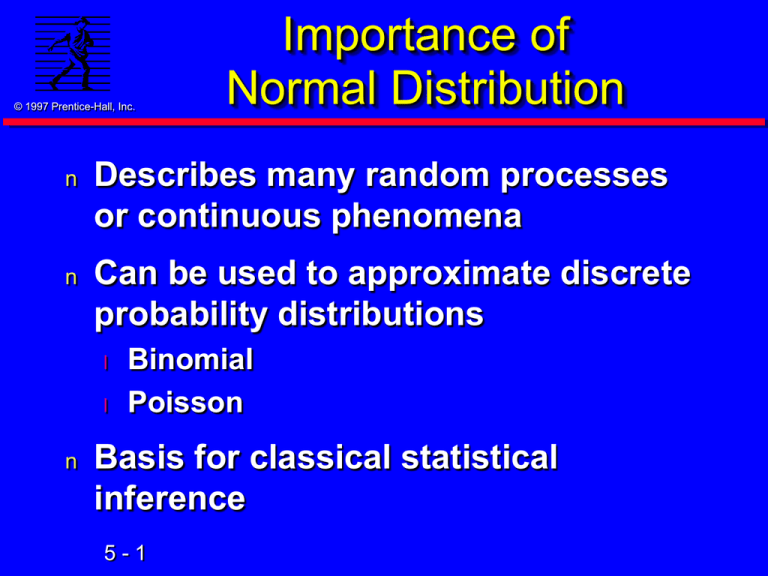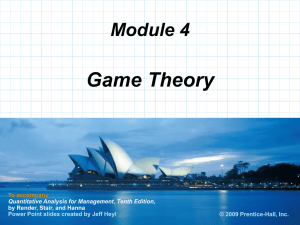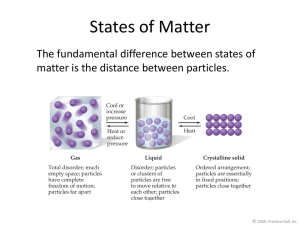Chap. 5: The Normal Distribution & Sampling Distributions
advertisement

© 1997 Prentice-Hall, Inc. Importance of Normal Distribution n Describes many random processes or continuous phenomena n Can be used to approximate discrete probability distributions l l n Binomial Poisson Basis for classical statistical inference 5-1 Normal Distribution © 1997 Prentice-Hall, Inc. n n n n ‘Bell-shaped’ & symmetrical f(X) Mean, median, mode are equal ‘Middle spread’ is 1.33 s Random variable has infinite range 5-2 X Mean Median Mode Standardize the Normal Distribution © 1997 Prentice-Hall, Inc. X Z s Normal Distribution Standardized Normal Distribution s s= 1 X = 0 One table! 5-3 Z Standardizing Example © 1997 Prentice-Hall, Inc. Normal Distribution s = 10 = 5 6.2 X 5-4 Standardizing Example © 1997 Prentice-Hall, Inc. X 6.2 5 Z .12 s 10 Normal Distribution s = 10 = 5 6.2 X 5-5 Standardized Normal Distribution s=1 = 0 .12 Z Obtaining the Probability © 1997 Prentice-Hall, Inc. Standardized Normal Probability Table (Portion) Z .00 .01 s=1 .02 0.0 .0000 .0040 .0080 .0478 0.1 .0398 .0438 .0478 0.2 .0793 .0832 .0871 = 0 .12 Z 0.3 .1179 .1217 .1255 Probabilities 5-6 Shaded area exaggerated © 1997 Prentice-Hall, Inc. 5-7 Example P(3.8 X 5) Example P(3.8 X 5) © 1997 Prentice-Hall, Inc. X 3.8 5 Z .12 s 10 Normal Distribution Standardized Normal Distribution s = 10 s=1 .0478 3.8 = 5 5-8 X -.12 = 0 Shaded area exaggerated Z © 1997 Prentice-Hall, Inc. 5-9 Example P(2.9 X 7.1) © 1997 Prentice-Hall, Inc. Example P(2.9 X 7.1) Z Normal Distribution Z X 2.9 5 .21 s 10 X 7.1 5 .21 Standardized s 10 Normal Distribution s = 10 s=1 .1664 .0832 .0832 2.9 5 7.1 X 5 - 10 -.21 0 .21 Shaded area exaggerated Z © 1997 Prentice-Hall, Inc. 5 - 11 Example P(X 8) Example P(X 8) © 1997 Prentice-Hall, Inc. X 85 Z .30 s 10 Normal Distribution Standardized Normal Distribution s = 10 s=1 .5000 .3821 .1179 =5 5 - 12 8 X =0 Shaded area exaggerated .30 Z Central Limit Theorem © 1997 Prentice-Hall, Inc. As sample size gets large enough ( 30) ... sampling distribution becomes almost normal. X X 5 - 13 © 1997 Prentice-Hall, Inc. Introduction to Estimation 5 - 14 Statistical Methods © 1997 Prentice-Hall, Inc. Statistical Statistical Methods Methods Descriptive Descriptive Statistics Statistics Inferential Inferential Statistics Statistics Estimation Estimation 5 - 15 Hypothesis Hypothesis Testing Testing Estimation Process © 1997 Prentice-Hall, Inc. Population J J Mean, , is unknown J J J Sample J J J J 5 - 16 Random Sample Mean J J`X = 50 I am 95% confident that is between 40 & 60. © 1997 Prentice-Hall, Inc. Population Parameters Are Estimated Estimate population population parameter... parameter... Mean with sample sample statistic statistic `x Proportion Proportion p pss Variance s 22 s 11 22 `x11 -`x22 Differences Differences 5 - 17 22 Point Estimation © 1997 Prentice-Hall, Inc. n Provides single value l n n Based on observations from 1 sample Gives no information about how close value is to the unknown population parameter Example: Sample mean`X = 3 is point estimate of unknown population mean 5 - 18 Interval Estimation © 1997 Prentice-Hall, Inc. n Provides range of values l n Gives information about closeness to unknown population parameter l n Based on observations from 1 sample Stated in terms of probability Example: Unknown population mean lies between 50 & 70 with 95% confidence 5 - 19 © 1997 Prentice-Hall, Inc. Key Elements of Interval Estimation A probability that the population parameter falls somewhere within the interval. Confidence interval Confidence limit (lower) 5 - 20 Sample statistic (point estimate) Confidence limit (upper) Confidence Limits for Population Mean © 1997 Prentice-Hall, Inc. Parameter = Statistic ± Error © 1984-1994 T/Maker Co. 5 - 21 (1) X Error (2) Error X or X X (3) Z (4) Error Zs xx (5) X Zs x sx Error s xx © 1997 Prentice-Hall, Inc. Many Samples Have Same Interval `X = ± Zs`x sx_ -1.65s`x +1.65s`x 90% Samples 5 - 22 `X © 1997 Prentice-Hall, Inc. Many Samples Have Same Interval `X = ± Zs`x sx_ -1.65s`x -1.96s`x +1.65s`x +1.96s`x 90% Samples 95% Samples 5 - 23 `X © 1997 Prentice-Hall, Inc. Many Samples Have Same Interval `X = ± Zs`x sx_ -2.58s`x -1.65s`x -1.96s`x +1.65s`x +2.58s`x +1.96s`x 90% Samples 95% Samples 99% Samples 5 - 24 `X Level of Confidence © 1997 Prentice-Hall, Inc. n n Probability that the unknown population parameter falls within interval Denoted (1 - a)% l n ais probability that parameter is not within interval Typical values are 99%, 95%, 90% 5 - 25 © 1997 Prentice-Hall, Inc. Intervals & Level of Confidence Sampling Distribution a/2 of Mean sx__ 1 -a a/2 `x = X (1 - a) % of intervals contain . Intervals extend from `X - Zs`X to `X + Zs`X a % do not. Large number of intervals 5 - 26 _ © 1997 Prentice-Hall, Inc. n Data dispersion l n Measured by s Intervals extend from `X - Zs`X to`X + Zs`X Sample size l n Factors Affecting Interval Width s`X = s / n Level of confidence (1 - a) l Affects Z © 1984-1994 T/Maker Co. 5 - 27 Confidence Interval Estimates © 1997 Prentice-Hall, Inc. Confidence Confidence Intervals Intervals Mean Mean sKnown sKnown 5 - 28 Proportion Proportion ss Unknown Unknown Variance Variance Finite Finite Population Population © 1997 Prentice-Hall, Inc. Confidence Interval Estimate Mean (s Known) 5 - 29 Confidence Interval Estimates © 1997 Prentice-Hall, Inc. Confidence Confidence Intervals Intervals Mean Mean ss Known Known 5 - 30 Proportion Proportion ss Unknown Unknown Variance Variance Finite Finite Population Population © 1997 Prentice-Hall, Inc. n Confidence Interval Mean (s Known) Assumptions l l l Population standard deviation is known Population is normally distributed If not normal, can be approximated by normal distribution (n 30) 5 - 31 © 1997 Prentice-Hall, Inc. n Assumptions l l l n Confidence Interval Mean (s Known) Population standard deviation is known Population is normally distributed If not normal, can be approximated by normal distribution (n 30) Confidence interval estimate s X Za / 2 X Za / 2 n 5 - 32 s n © 1997 Prentice-Hall, Inc. Estimation Example Mean (s Known) The mean of a random sample of n = 25 is`X = 50. Set up a 95% confidence interval estimate for if s = 10. 5 - 33 © 1997 Prentice-Hall, Inc. Estimation Example Mean (s Known) The mean of a random sample of n = 25 is`X = 50. Set up a 95% confidence interval estimate for if s = 10. s s X Za / 2 X Za / 2 n n 10 10 50 1.96 50 1.96 25 25 46.08 53.92 5 - 34 Confidence Interval Solution* © 1997 Prentice-Hall, Inc. X Za / 2 s n X Za / 2 s n .05 1.99 1.645 1.99 1.645 100 1.982 1.998 5 - 35 .05 100 © 1997 Prentice-Hall, Inc. Confidence Interval Estimate Mean (s Unknown) 5 - 36 Confidence Interval Estimates © 1997 Prentice-Hall, Inc. Confidence Confidence Intervals Intervals Mean Mean ss Known Known 5 - 37 Proportion Proportion sUnknown sUnknown Variance Variance Finite Finite Population Population © 1997 Prentice-Hall, Inc. n Assumptions l l n n Confidence Interval Mean (s Unknown) Population standard deviation is unknown Population must be normally distributed Use Student’s t distribution Confidence interval estimate S S X t a / 2, n 1 X t a / 2, n 1 n n 5 - 38 Student’s t Distribution © 1997 Prentice-Hall, Inc. Standard Bellnormal shaped Symmetric t (df = 13) ‘Fatter’ tails t (df = 5) 0 5 - 39 Z t Student’s t Table © 1997 Prentice-Hall, Inc. Upper Tail Area df .25 .10 Assume: n=3 df =n-1 =2 a = .10 a/2 =.05 a/2 .05 1 1.000 3.078 6.314 2 0.817 1.886 2.920 .05 3 0.765 1.638 2.353 0 t values 5 - 40 t Student’s t Table © 1997 Prentice-Hall, Inc. Upper Tail Area df .25 .10 Assume: n=3 df =n-1 =2 a = .10 a/2 =.05 a/2 .05 1 1.000 3.078 6.314 2 0.817 1.886 2.920 .05 3 0.765 1.638 2.353 0 t values 5 - 41 2.920 t © 1997 Prentice-Hall, Inc. Estimation Example Mean (s Unknown) A random sample of n = 25 has`X = 50 & S = 8. Set up a 95% confidence interval estimate for . S X t a / 2, n 1 X t a / 2, n 1 n 8 50 2.0639 50 2.0639 25 46.69 53.30 5 - 42 S n 8 25 Thinking Challenge © 1997 Prentice-Hall, Inc. You’re a time study analyst in manufacturing. You’ve recorded the following task times (min.): 3.6, 4.2, 4.0, 3.5, 3.8, 3.1. What is the 90% confidence interval estimate of the population mean task time? 5 - 43 Alone Group Class © 1997 Prentice-Hall, Inc. Confidence Interval Solution* `X = 3.7 S = 3.8987 n = 6, df = n - 1 = 6 - 1 = 5 S / n = 3.8987 / 6 = 1.592 t.05,5 = 2.0150 3.7 - (2.015)(1.592) 3.7 + (2.015)(1.592) 0.492 6.908 5 - 44 © 1997 Prentice-Hall, Inc. Estimation of Mean for Finite Populations 5 - 45 Confidence Interval Estimates © 1997 Prentice-Hall, Inc. Confidence Confidence Intervals Intervals Mean Mean sKnown sKnown 5 - 46 Proportion Proportion ss Unknown Unknown Variance Variance Finite Finite Population Population © 1997 Prentice-Hall, Inc. n Estimation for Finite Populations Assumptions l Sample is large relative to population s n / N > .05 n Use finite population correction factor n Confidence interval (mean, s unknown) S Nn X t aa //22,, nn11 X t aa //22,, nn11 n N 1 5 - 47 S Nn n N 1 © 1997 Prentice-Hall, Inc. Confidence Interval Estimate of Proportion 5 - 48 Confidence Interval Estimates © 1997 Prentice-Hall, Inc. Confidence Confidence Intervals Intervals Mean Mean sKnown sKnown 5 - 49 Proportion Proportion ss Unknown Unknown Variance Variance Finite Finite Population Population © 1997 Prentice-Hall, Inc. n Assumptions l l l n Confidence Interval Proportion Two categorical outcomes Population follows binomial distribution Normal approximation can be used s n·p 5 & n·(1 - p) 5 Confidence interval estimate pss (1 pss ) pss (1 pss ) pss Z p pss Z n n 5 - 50 © 1997 Prentice-Hall, Inc. Estimation Example Proportion A random sample of 400 graduates showed 32 went to grad school. Set up a 95% confidence interval estimate for p. 5 - 51 © 1997 Prentice-Hall, Inc. Estimation Example Proportion A random sample of 400 graduates showed 32 went to grad school. Set up a 95% confidence interval estimate for p. pss (1 pss ) pss (1 pss ) pss Z aa//22 p pss Z aa//22 n n .08 (1 .08) .08 (1 .08) .08 1.96 p .08 1.96 400 400 .053 p .107 5 - 52 Thinking Challenge © 1997 Prentice-Hall, Inc. You’re a production manager for a newspaper. You want to find the % defective. Of 200 newspapers, 35 had defects. What is the 90% confidence interval estimate of the population proportion defective? 5 - 53 Alone Group Class © 1997 Prentice-Hall, Inc. Confidence Interval Solution* n·p 5 n·(1 - p) 5 pss (1 pss ) pss (1 pss ) pss Z aa//22 p pss Z aa//22 n n .175 (.825) .175 (.825) .175 1.645 p .175 1.645 200 200 .1308 p .2192 5 - 54 This Class... © 1997 Prentice-Hall, Inc. Please take a moment to answer the following questions in writing: n What was the most important thing you learned in class today? n What do you still have questions about? n How can today’s class be improved? 5 - 55









